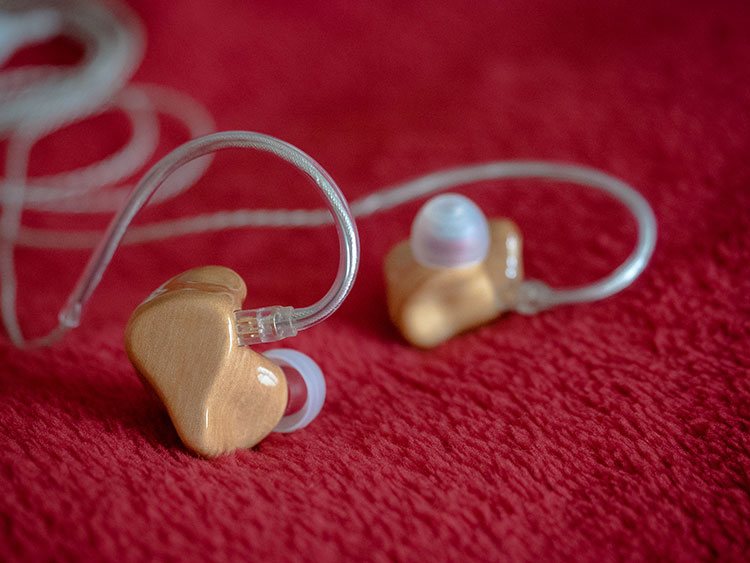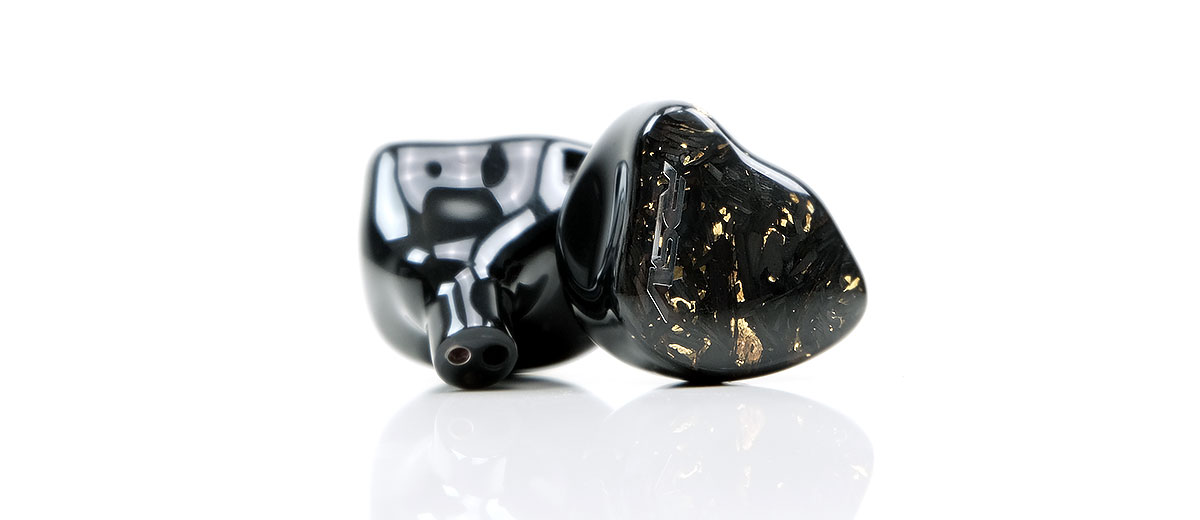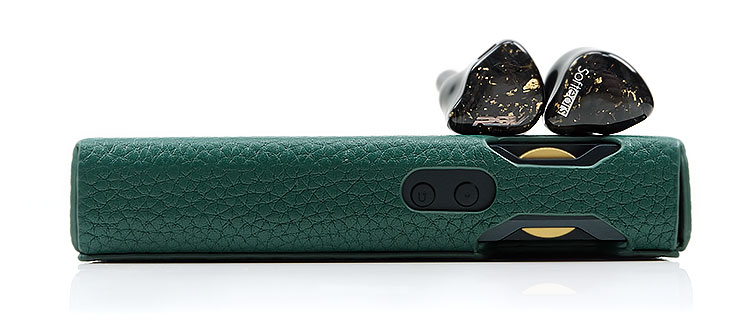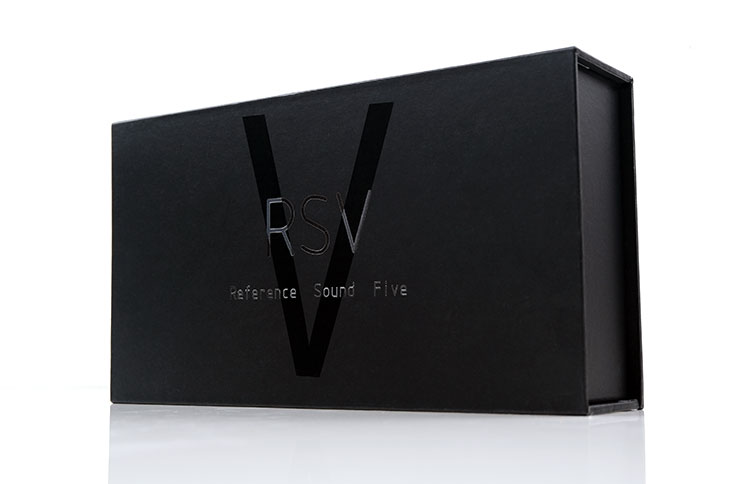Synergy
Efficiency
The RSV is rated at 8Ω and 125db/1VRMS @1kHz SPL, which on initial impression would make it seem to be a highly sensitive monitor.
However, one does have to be somewhat careful regarding the benchmarked weighting for the SPL rating as our real-world tests placed this more in a medium efficiency category. Competing monitors with lower SPL ratings proved to be more efficient and requiring less current on our test DAP, the Lotoo PAW Gold Touch, in low gain SE mode.
For example, the MMR Gae Bolg is rated at 25Ω and around 98dB SPL but required maybe around 1-2dB less current compared to the RSV. The InEar StageDiver 5 is rated at 13Ω and 120dB SPL and it too was also more current sensitive getting louder faster on the same SE low gain output testing process.
The good news is that the RSV plays out really well with sources that have a higher than average noise floor or offer a bit of background hiss with sensitive IEMs. Testing with the FiiO M15 and the HiBy R8 using a balanced cable (EA Grandioso), delivered a well-behaved and very low noise floor with no hiss on the M15 and a very minor noise floor with the R8.
Pairings
Out of the 5 DAPs that were tested with the RSV I pretty much came to the conclusion that a neutral or clean source paired best with the RSV. This boiled down to how much treble presence you want in the RSV mix and whilst I am not a huge treble head I do like a little sparkle and for timbre not to sound overly rounded.
The RSV is relatively relaxed in its imaging and not hugely aggressive so DAPs like the iBasso DX300 do very well for staging width and depth but less so for vocal presence and treble energy.
The timbral quality is excellent with this pairing as are most sources given how likable in general the RSV coloration generally is. The deciding factor is really how much treble the DX300 could tease out of the RSV which wasn’t huge. This pairing is more to the forgiving side and might not feel as engaged as the neutral alternatives.
You could argue the same for the flagship R2R DAP, the LP P6 Pro which doesn’t have a very peppy top-end either but it does offer much better texture on the low-end to the mids which I find compensates a bit for the languid treble.
The R2R’s stronger sub-bass presence laps up the dynamic range and level of textural detail offered by the P6 Pro to produce a wonderfully planted sound signature with excellent body.
Perhaps the two most balanced pairings were the M15 and the Lotoo PAW Touch Gold. Both are relatively neutral sound signatures with the M15 offering a bit more treble energy and the Lotoo a bit firmer in body.
Both tease out more treble presence from the RSV and stretch the soundstage quite nicely. Not as much body or power as the R8 or the P6 Pro but definitely cleaner and airier.
Select Comparisons
Campfire Audio Andromeda 2020
$1099
Technical
Andromeda is probably one of the most high-profile 5 driver BA universal monitors in recent years. It has had a number of revisions so the one for comparison here is the most recent 2020 version.
Inside, the Andromeda 2020 driver grouping is quite similar though the surrounding tech is a bit different. The Andromeda has the same 2 BA for the lows, 1 full-range BA for the mids, and a tweeter for the highs.
The big difference is in the tubeless T.E.A.C. technology CA uses for the Andromeda highs whereas Softears focuses a lot more on the filtering and crossover technology for phase control inside the RSV.
Both do offer 3D printed internal constructions with the RSV offering a strong focus on optimizing the sound tubing size and length whereas the Andromeda 2020 internal design is more about the end result given the design has more tubeless elements.
Both look very easy to drive on paper with the Andromeda rated at 12.8Ω and the RSV even lower at 8Ω. However, there is no like for like on SPL as CA uses a 94dB benchmarked rating so it’s 7.01 mVrms to hit 94dB @1kHz. The RSV uses a traditional system and is rated at 125db/1VRMS @1kHz.
In our real-world tests with the Lotoo PAW Gold Touch in SE low-gain, the Andromeda 2020 was by far the more sensitive of the two monitors which does not really surprise me.
Design
Very different designs here with the RSV a lighter heavily contoured acrylic hollow body shell and the Andromeda 2020 using more robust and heavier zirconium blasted aluminum materials.
Fitting is topical with the Andromeda with its edged design though it is smaller in dimensions when side by side the RSV. It is really the contouring of the RSV with its good nozzle length that gives it a comfort and isolation advantage. Not that the Andromeda is bad but rather it is harder to contour aluminum so it a bit leakier in terms of isolation.
I will say, however, CA’s inclusion of Final E tips is an excellent choice for both tuning and isolation. Here the Andromeda can close the gap a bit on the RSV with its silicone tips.
Both have decent cables with the Andromeda using a 1.32m MMCX terminated 4-wire SPC Litz geometry with a smokey finished jacket. The RSV uses a 5N copper Litz 4-wire in an all-black PU jacket with a tight braid and finished with 2-pin 0.78m connectors. The RSV cable feels a little bit more premium in its external finishing but both handle well with low microphonics.
Performance
These two monitors sound very different to me which was surprising given their charts ‘seem’ to be in the same general ballpark. The Andromeda presentation is much lighter in weight, a thinner but more articulate note, with a warmish mid-bass bias and a stronger treble extension.
The RSV is more planted, heavier on the low-end with a better sub-bass presence but perhaps less mid-bass punch. Its peak is more upper-mids around 3k with a slow linear fade into the upper treble so it sounds much more relaxed, smoother, and slightly warmer in its instrumental and vocal timbre.
In terms of staging, both have a good vocal presence, slightly forward but not in your face. Andromeda’s stronger treble focus will give the Andromeda 2020 a bit more bite and perceived percussion presence.
It also stages a bit wider casting a better stereo imaging experience than the RSV’s more centered sound. Higher pitching spatial cues might be a bit easier to spot with Andromeda’s busier treble tuning compared to the relaxed top-end of the RSV.
Overall, the Andromeda 2020 is certainly a lot smoother than the original version but it’s still a bit brighter and airier compared to the RSV weightier and smoother presentation.
MMR Gae Bolg
$1199
Technical
The Gae Bolg is another competing all 5 BA universal IEM and one we reviewed at the end of 2020. Internally, the Gae Bolg has a slightly different configuration to the RSV with a dual vented bass BA for the lows, a single full-range BA with bandpass for the mids, a vented BA for the mid-highs, and a tweeter for the highs.
The RSV groups it a bit tighter with 2 for the lows, a single full range for the mids, and dual-tweeters for the highs. Both have invested heavily in their crossover technology with the RSV using a 3-way and the Gae Bolg using a 4-way and both have 3D printed internal acoustic chamber designs.
The Gae Bolg uses their own 4-way Electro Frequency Division crossover with a fusion of passive electronic components coupled with a specific RLC filter circuit. The RSV crossover consists of a 3rd order LRC filter for bass, an impedance and low pass for the midrange, as well as a film capacitor for the high frequencies.
The Gae Bolg is rated at 25Ω and around 98dB SPL whereas the RSV seems more sensitive on paper at just 8Ω and 125dB SPL. However, it is the Gae Bolg that is the more current sensitive compared to the RSV by around 1-2dB using the Lotoo PAW Gold Touch in low gain.
Design
The best summary would be the aesthetics award going to the Gae Bolg but the comfort and isolation award going to the RSV.
The Gae Bolg is a two-tone CNC aluminum dual beveled design with a gunmetal colored fine matte base shell. This shell sits underneath an incredibly intricate 3-dimensional crimson red faceplate. It’s a real stand-out design and whilst I compliment the RSV for its intricate flake pattern it does look a little subdued beside the Gae Bolg.
The edge for the RSV is in the form factor and those contoured lines make it a supremely comfortable lightweight fit. The Gae Bolg feels more regimented in its lines on the underside with a lot of emphasis on the tips to create a seal. As a result, it feels a little less secure and a bit leaker for isolation.
The Gae Bolg stock cable is just ok compared to the slightly better finish of the RSV cable. The Gae Bolg comes with a 1.2m 4-wire SPC wire with a Litz geometry inside a tightly braided black PVC jacket.
Performance
I think both monitors are aiming for that classic ‘pleasing’ curve but the Gae Bolg is the more aggressive and forward-sounding whereas the RSV is more laid back and smoother through the mids.
On the low-end, the Gae Bolg elevation has a rise into the mid-bass and a very slow drop down to 1k. The RSV has more of a sub-bass bias with a faster drop post-100Hz and a fairly linear and neutral response up to 1k. You get a stronger sense of separation from the bass to the mids on the RSV but more body and warmth from the Gae Bolg.
Of the two, the Gae Bolg bass is going sound punchier, busier, and more aggressive but the RSV extends that bit better with more sub-bass presence leaving more space for the mids to breathe.
Through the mids, the Gae Bolg has a much bigger 1-2k boost but it is a narrow band boost with a strong drop from 3-4k. Vocal presence sounds quite pronounced, forward, and intimate on the Gae Bolg.
The RSV peaks a little higher at 3k, but the rise from 1k to 3k is a bit more gradual with no subsequent suckout beyond. The RSV is just a bit smoother in its midrange tuning with vocals sitting a little further back. It is not as vibrant or energetic as the Gae Bolg tuning but it sounds more coherent and natural to my ear.
One of the factors in that smoother timbre is the treble tuning. The Gae Bolg has another narrow-band 5-7k peak whereas the RSV has a gradual fade from its 3k peak down to 10k without any major bumps. You get more bite in the Gae Bolg vocal and percussion timbre and a liquid overtone in the RSV equivalent.
InEar StageDiver 5
$899
Technical
The StageDiver 5 to SD5 is once again, a 5 BA driver universal IEM with a pricing a lot closer to the RSV than either the Andromeda 2020 or the Gae Bolg.
The internal driver configuration of the SD5 is quite similar to the RSV with a 2 BA for the lows, 1 for the mid, and a dual tweeter for the treble using a 3-way crossover. The RSV is the exact same in terms of grouping and crossover with 2 for the lows, 1 for the mids, and a dual tweeter for the highs. InEar does not go into much detail beyond that for the type of crossover used.
The SD5 is rated at 13Ω and 120dB SPL which is fairly sensitive though not quite as much on paper as the RSV at 8Ω and 125dB SPL.
In real-world testing, the SD5 proved to be the more current-sensitive of the two which indicates Softears probably used a slightly different weighting for the RSV. My guess is that the RSV is closer to <110dB if the SD5 is a true 120dB SPL rating.

Design
Aesthetics will depend on which version of the SD5 you purchase. You can get some beautiful wood designs but you can also buy them in a very plain all-black acrylic shell. With the latter, the RSV is the snazzier-looking acrylic design with its gold flake and carbon fiber plate. With the former, the SD5 might be the more exotic looking of the two.
The form factor and contouring on both are very aggressive with the SD5 perhaps being the more aggressive of the two for bumps and crevices. It is a bit longer than the RSV but also shallower with a very short nozzle.
Both, however, have excellent isolation levels with only the slightly larger dimension of the SD5 creating a sense of pressure on my outer ear that the RSV does not do.
The RSV switches the pressure bias a bit more inside the ear canal with a deeper insertion to produce its excellent seal. The SD5’s shallow depth and heavier contouring means the nozzle does not have to be as long as it sits really tight in my coach basin.
The one drawback of the SD5 package is the cheap P1 Tech 4-wire OFC cable. I have no issues with its lightweight handling and low microphonics. Rather its dynamic range is weaker than the RSV’s cable likely due to the wire carrying a bit more impedance (1.8Ω).
Performance
Up to the mids, the difference between these two is more nuanced than stark. Beyond 1k the two monitors diverge with the SD5 offering a lot more energy from 7-10k that in turn creates a slightly more ethereal airy tone from the upper-mids into the lower treble that InEar has tried to suppress somewhat with a focused dip around 4-6k.
On the low-end, both have some nice sub-bass weight, in fact quite similar for me up to around 50Hz. From there the RSV dips quite markedly to run a flatter more neutral line up to 1k with less mid-bass warmth and bloom.
The SD5 retains more amplitude up to 400Hz but after a sharper drop into the lower-mids up to 1k. You get some additional warmth and bloom into the upper bass as a result but also a lower-midrange that perhaps lacks a little presence being sandwiched between a forward bass and midrange.
Both have presence into the mids but the SD5 is more immediate from 1-4k through whereas the RSV is more gradual up to 3k so vocals are more intimate and immediate on the SD5 and a little more laid back but still quite clear on the RSV.
Midrange timbre on the SD5 has a slight sheen from the upper treble boost which results in a bit more contrast for instrument and vocal notes. Whereas the RSV treble fades gently into the upper treble and has a greater even-harmonic bias sounding a little smoother.
Our Verdict
There is a delicious irony to the fact this monitor was tuned by a company called Softears because ultimately that is what resonates for me when listening to the RSV. The timbral coloration is beautifully euphonic, delivering an intoxicating sound signature that is very easy to listen to.
Nothing seems out of place with the RSV presentation and I am conscious some might term the tuning as a ‘safe bet’, as in not disagreeable but not taking a risk either.
Certainly, the rather stunted staging quality might hold back the hardened purist from forking out their hard-earned cash but Softears do have an answer to that with their RS10 flagship which we will have a review for very soon.
For now, this 5-driver monitor is a ‘travel bagger’, the type of quality IEM that seems a constant choice for some emotive listening on the road, flights (if ever that happens in Covid times), and just whiling the time away listening to great music. Isn’t that what this hobby is all about anyway?
Softears RSV Specifications
- Sensitivity: 125db/1VRMS @1kHz
- Impedance: 8Ω @1kHz (±15%)
- Frequency Range: 5Hz – 40kHz (1/4’ Free Field, -3dB)
- Effective Frequency Response: 20Hz – 20kHz (IEC-60318-4)
- THD+IMD @94dB: <1% @1kHz
- Cable Connection: 2-Pin 0.78mm
- Shell: 3D Printed from Imported Medical Resin
- Driver Configuration: 5 Balanced Armatures





